#american colony history
Explore tagged Tumblr posts
Text

Has everyone been enjoying the live action of One Piece on Netflix? We thought we might use this opportunity to discuss some similarities and differences between Captain Kidd, and a character in One Piece inspired by him, Eustass Kid. Similarities ~ Both are rather large and intimidating by appearance! But what male pirate in One Piece isn’t built like that? The key difference with Eustass Kid lies entirely on his raw strength, which is a rarity for characters this late in the series and for those who are as wanted and as deadly as Kid. He wouldn’t get devil fruit abilities until late in his pirate career. This was likely inspired by the fact that William Kidd was a very strong man thanks to his size and experience as a hard working sailor.
William Kidd and Eustass Kid had similar networking in their past. For Eustass Kid, he had large ties with other powerful allies being apart of a gang on the islands he lived. William Kidd’s networking in New York was thanks to his reputation as a war hero and he quickly became friends with other powerful merchants and governors. Being married to a wealthy and successful wife helped with this too.
Both Kidd and Kid have a big ego and crave success. Eustass Kid, like many pirates in One Piece, is strongly motivated by personal gain and seeking the One Piece. There is plenty of documentation that suggests William Kidd also was easily flattered and sought to claim fame and glory for himself, as his last voyage was an attempt to gain a higher ranking career since being a ship merchant Captain from New York was not enough for him. Differences ~ Eustass Kid is introduced with a very high bounty in the series due to the high amounts of casualties of civilians he was responsible for. While the real William Kidd did not have this experience, this could have been inspired by the infamous reputation about Captain Kidd, especially during the time right before his capture and execution - the world generally feared Captain Kidd due to many rumors that had spread across the seas.
Eustass will eventually get a cybernetic left arm in the series. William never lost any limbs.
And the BIG difference - Eustass Kid is unquestionably a pirate. But William Kidd? He was no true pirate and was wrongfully accused of such!
For those One Piece fans curious to learn more about the real William Kidd, check out our website pardonwilliamkidd.com. Unlike Eustass Kid, William Kidd’s history shows he was innocent of piracy and we continue to work towards correcting this wrong in history - and helping the Captain receive a pardon!
#captain kidd#william kidd#kidd#pardon captain kidd#one piece#eustass kid#kid pirates#history#pirate history#american colony history#american history#scottish#captain#nautical
23 notes
·
View notes
Text
17/12/23 this masterlist has been completely revamped with free access to all material. It will be updated and edited periodically so please click on my username and reblog the current version directly from me if you're able.
14/8/24 reboosting this post with How to Help Palestine updated. Please scroll to the bottom to donate or boost the links.
Palestine: The Big Damn List
(Yes, it's a lot. Just choose your preferred medium and then pick ONE.)
Podcasts
Backgrounders and Quick Facts
Interactive Maps
Teach-Out Resources
Reading Material (free)
Films and Documentaries (free)
Non-Governmental Organizations
Social Media
How You Can Help <- URGENT!!!
Podcasts
Cocktails & Capitalism: The Story of Palestine Part 1, Part 3
It Could Happen Here: The Cheapest Land is Bought with Blood, Part 2, The Balfour Declaration
Citations Needed: Media narratives and consent manufacturing around Israel-Palestine and the Gaza Siege
The Deprogram: Free Palestine, ft. decolonizatepalestine.com.
Backgrounders and Quick Facts
The Palestine Academy: Palestine 101
Institute for Middle East Understanding: Explainers and Quick Facts
Interactive Maps
Visualizing Palestine
Teach-Out Resources
1) Cambridge UCU and Pal Society
Palestine 101
Intro to Palestine Film + Art + Literature
Resources for Organising and Facilitating)
2) The Jadaliya YouTube Channel of the Arab Studies Institute
Gaza in Context Teach-in series
War on Palestine podcast
Updates and Discussions of news with co-editors Noura Erakat and Mouin Rabbani.
3) The Palestine Directory
History (virtual tours, digital archives, The Palestine Oral History Project, Documenting Palestine, Queering Palestine)
Cultural History (Palestine Open Maps, Overdue Books Zine, Palestine Poster Project)
Contemporary Voices in the Arts
Get Involved: NGOs and campaigns to help and support.
3) PalQuest Interactive Encyclopedia of the Palestine Question.
4) The Palestine Remix by Al Jazeera
Books and Articles
Free reading material
My Gdrive of Palestine/Decolonization Literature (nearly all the books recommended below + books from other recommended lists)
Five free eBooks by Verso
Three Free eBooks on Palestine by Haymarket
LGBT Activist Scott Long's Google Drive of Palestine Freedom Struggle Resources
Recommended Reading List
Academic Books
Edward Said (1979) The Question of Palestine, Random House
Ilan Pappé (2002)(ed) The Israel/Palestine Question, Routledge
Ilan Pappé (2006) The Ethnic Cleansing of Palestine, OneWorld Publications
Ilan Pappé (2011) The Forgotten Palestinians: A History of the Palestinians in Israel, Yale University Press
Ilan Pappé (2015) The Idea of Israel: A History of Power and Knowledge, Verso Books
Ilan Pappé (2017) The Biggest Prison On Earth: A History Of The Occupied Territories, OneWorld Publications
Ilan Pappé (2022) A History of Modern Palestine, Cambridge University Press
Rosemary Sayigh (2007) The Palestinians: From Peasants to Revolutionaries, Bloomsbury
Andrew Ross (2019) Stone Men: the Palestinians who Built Israel, Verso Books
Rashid Khalidi (2020) The Hundred Years’ War on Palestine: A History of Settler Colonialism and Resistance 1917–2017
Ariella Azoulay (2011) From Palestine to Israel: A Photographic Record of Destruction and State Formation, 1947-1950, Pluto Press
Ariella Azoulay and Adi Ophir (2012) The One-State Condition: Occupation and Democracy in Israel/Palestine, Stanford University Press.
Jeff Halper (2010) An Israeli in Palestine: Resisting Dispossession, Redeeming Israel, Pluto Press
Jeff Halper (2015) War Against the People: Israel, the Palestinians and Global Pacification
Jeff Halper (2021) Decolonizing Israel, Liberating Palestine: Zionism, Settler Colonialism, and the Case for One Democratic State, Pluto Press
Anthony Loewenstein (2023) The Palestine Laboratory: How Israel exports the Technology of Occupation around the World
Noura Erakat (2019) Justice for Some: Law and the Question of Palestine, Stanford University Press
Neve Gordon (2008) Israel’s Occupation, University of California Press
Joseph Massad (2006) The Persistence of the Palestinian Question: Essays on Zionism and the Palestinians, Routledge
Memoirs
Edward Said (1986) After the Last Sky: Palestine Lives, Columbia University PEdward Saidress
Edward Said (2000) Out of Place; A Memoir, First Vintage Books
Mourid Barghouti (2005) I saw Ramallah, Bloomsbury
Hatim Kanaaneh (2008) A Doctor in Galilee: The Life and Struggle of a Palestinian in Israel, Pluto Press
Raja Shehadeh (2008) Palestinian Walks: Into a Vanishing Landscape, Profile Books
Ghada Karmi (2009) In Search of Fatima: A Palestinian Story, Verso Books
Vittorio Arrigoni (2010) Gaza Stay Human, Kube Publishing
Ramzy Baroud (2010) My Father Was a Freedom Fighter: Gaza's Untold Story, Pluto Press
Izzeldin Abuelaish (2011) I Shall Not Hate: A Gaza Doctor’s Journey on the Road to Peace and Human Dignity, Bloomsbury
Atef Abu Saif (2015) The Drone Eats with Me: A Gaza Diary, Beacon Press
Anthologies
Voices from Gaza - Insaniyyat (The Society of Palestinian Anthropologists)
Letters From Gaza • Protean Magazine
Salma Khadra Jayyusi (1992) Anthology of Modern Palestinian Literature, Columbia University Press
ASHTAR Theatre (2010) The Gaza Monologues
Refaat Alreer (ed) (2014) Gaza Writes Back, Just World Books
Refaat Alreer, Laila El-Haddad (eds) (2015) Gaza Unsilenced, Just World Books
Cate Malek and Mateo Hoke (eds)(2015) Palestine Speaks: Narrative of Life under Occupation, Verso Books
Jehad Abusalim, Jennifer Bing (eds) (2022) Light in Gaza: Writings Born of Fire, Haymarket Books
Short Story Collections
Ghassan Kanafani, Hilary Kilpatrick (trans) (1968) Men in the Sun and Other Palestinian Stories, Lynne Rienner Publishers
Ghassan Kanafani, Barbara Harlow, Karen E. Riley (trans) (2000) Palestine’s Children: Returning to Haifa and Other Stories, Lynne Rienner Publishers
Atef Abu Saif (2014) The Book of Gaza: A City in Short Fiction, Comma Press
Samira Azzam, Ranya Abdelrahman (trans) (2022) Out Of Time: The Collected Short Stories of Samira Azzam
Sonia Sulaiman (2023) Muneera and the Moon; Stories Inspired by Palestinian Folklore
Essay Collections
Edward W. Said (2000) Reflections on Exile and Other Essays, Harvard University Press
Salim Tamari (2008) Mountain against the Sea: Essays on Palestinian Society and Culture, University of California Press
Fatma Kassem (2011) Palestinian Women: Narratives, histories and gendered memory, Bloombsbury
Ramzy Baroud (2019) These Chains Will Be Broken: Palestinian Stories of Struggle and Defiance in Israeli Prisons, Clarity Press
Novels
Sahar Khalifeh (1976) Wild Thorns, Saqi Books
Liyana Badr (1993) A Balcony over the Fakihani, Interlink Books
Hala Alyan (2017) Salt Houses, Harper Books
Susan Abulhawa (2011) Mornings in Jenin, Bloomsbury
Susan Abulhawa (2020) Against the Loveless World, Bloomsbury
Graphic novels
Joe Sacco (2001) Palestine
Joe Sacco (2010) Footnotes in Gaza
Naji al-Ali (2009) A Child in Palestine, Verso Books
Mohammad Sabaaneh (2021) Power Born of Dreams: My Story is Palestine, Street Noise Book*
Poetry
Fady Joudah (2008) The Earth in the Attic, Sheridan Books,
Ghassan Zaqtan, Fady Joudah (trans) (2012) Like a Straw Bird It Follows Me and Other Poems, Yale University Press
Hala Alyan (2013) Atrium: Poems, Three Rooms Press*
Mohammed El-Kurd (2021) Rifqa, Haymarket Books
Mosab Abu Toha (2022) Things You May Find Hidden in My Ear: Poems from Gaza, City Lights Publishers
Tawfiq Zayyad (2023) We Are Here to Stay, Smokestack Books*
The Works of Mahmoud Darwish
Poems
Rafeef Ziadah (2011) We Teach Life, Sir
Nasser Rabah (2022) In the Endless War
Refaat Alareer (2011) If I Must Die
Hiba Abu Nada (2023) I Grant You Refuge/ Not Just Passing
[All books except the ones starred are available in my gdrive. I'm adding more each day. But please try and buy whatever you're able or borrow from the library. Most should be available in the discounted Free Palestine Reading List by Pluto Press, Verso and Haymarket Books.]
Human Rights Reports & Documents
Information on current International Court of Justice case on ‘Legal Consequences arising from the Policies and Practices of Israel in the Occupied Palestinian Territory, including East Jerusalem’
UN Commission of Inquiry Report 2022
UN Special Rapporteur Report on Apartheid 2022
Amnesty International Report on Apartheid 2022
Human Rights Watch Report on Apartheid 2021
Report of the United Nations Fact-Finding Mission on the Gaza Conflict’ 2009 (‘The Goldstone Report’)
Advisory Opinion on the Legal Consequences of the Construction of a Wall in the Occupied Palestinian Territory, International Court of Justice, 9 July 2004
Films
Documentaries
Jenin, Jenin (2003) dir. Mohammed Bakri
Massacre (2005) dir. Monica Borgmann, Lokman Slim, Hermann Theissen
Slingshot HipHop (2008) dir. Jackie Reem Salloum
Waltz with Bashir (2008) dir. Ari Folman † (also on Amazon Prime)
Tears of Gaza (2010) dir. Vibeke Løkkeberg (also on Amazon Prime)
5 Broken Cameras (2011) dir. Emad Burnat (also on Amazon Prime)
The Gatekeepers (2012) dir. Dror Moreh (also on Amazon Prime)
The Great Book Robbery (2012) | Al Jazeera English
Al Nakba (2013) | Al Jazeera (5-episode docu-series)
The Village Under the Forest (2013) dir. Mark J. Kaplan
Where Should The Birds Fly (2013) dir. Fida Qishta
Naila and the Uprising (2017) (also on Amazon Prime)
GAZA (2019) dir. Andrew McConnell and Garry Keane
Gaza Fights For Freedom (2019) dir. Abby Martin
Little Palestine: Diary Of A Siege (2021) dir. Abdallah Al Khatib
Palestine 1920: The Other Side of the Palestinian Story (2021) | Al Jazeera World Documentary
Gaza Fights Back (2021) | MintPress News Original Documentary | dir. Dan Cohen
Innocence (2022) dir. Guy Davidi
Short Films
Fatenah (2009) dir. Ahmad Habash
Gaza-London (2009) dir. Dina Hamdan
Condom Lead (2013) dir. Tarzan Nasser, Arab Nasser
OBAIDA (2019) | Defence for Children Palestine
Theatrical Films
Divine Intervention (2002) | dir. Elia Suleiman (also on Netflix)
Paradise Now (2005) dir Hany Abu-Assad (also on Amazon Prime)
Lemon Tree (2008) (choose auto translate for English subs) (also on Amazon Prime)
It Must Be Heaven (2009) | dir. Elia Suleiman †
The Promise (2010) mini-series dir. Peter Kosminsky (Part 1, Part 2, Part 3, Part 4)
Habibi (2011)* dir. Susan Youssef
Omar (2013)* dir. Hany Abu-Assad †
3000 Nights (2015)* dir. Mai Masri
Foxtrot (2017) dir. Samuel Maoz (also on Amazon Prime)
The Time that Remains (2019) dir. Elia Suleiman †
Gaza Mon Amour (2020) dir. Tarzan Nasser, Arab Nasser †
The Viewing Booth (2020) dir. Ra'anan Alexandrowicz (on Amazon Prime and Apple TV)
Farha (2021)* | dir. Darin J. Sallam
Palestine Film Institute Archive
All links are for free viewing. The ones marked with a star (*) can be found on Netflix, while the ones marked † can be downloaded for free from my Mega account.
If you find Guy Davidi's Innocence anywhere please let me know, I can't find it for streaming or download even to rent or buy.
In 2018, BDS urged Netflix to dump Fauda, a series created by former members of IOF death squads that legitimizes and promotes racist violence and war crimes, to no avail. Please warn others to not give this series any views. BDS has not called for a boycott of Netflix. ]
NGOs
The Boycott, Divestment, Sanctions (BDS) Movement
Euro-Mediterranean Human Rights Monitor
UNRWA
Palestine Defence for Children International
Palestinian Feminist Collective
Al-Shabaka: The Palestinian Policy Network
Addameer Prisoner Support and Human Rights Association
Institute for Palestine Studies
Al Haq
Artists for Palestine
The Palestine Museum
Jewish Currents
B’Tselem
DAWN
Social Media
Palestnians on Tumblr
@el-shab-hussein
@killyfromblame
@apollos-olives
@fairuzfan
@palipunk
@sar-soor
@nabulsi
@wearenotjustnumbers2
@90-ghost
@tamarrud
@northgazaupdates
Allies and advocates (not Palestinian)
@bloglikeanegyptian beautiful posts that read like op-eds
@vyorei daily news roundups
@luthienne resistance through prose
@decolonize-the-left scoop on the US political plans and impacts
@feluka
@anneemay
(Please don't expect any of these blogs to be completely devoted to Palestine allyship; they do post regularly about it but they're still personal blogs and post whatever else they feel like. Do not harrass them.)
Gaza journalists
Motaz Azaiza IG: @motaz_azaiza | Twitter: @azaizamotaz9 | TikTok: _motaz.azaiza (left Gaza as of Jan 23)
Bisan Owda IG and TikTok: wizard_bisan1 | Twitter: @wizardbisan
Saleh Aljafarawi IG: @saleh_aljafarawi | Twitter: @S_Aljafarawi | TikTok: @saleh_aljafarawi97
Plestia Alaqad IG: @byplestia | TikTok: @plestiaaqad (left Gaza)
Wael Al-Dahdouh IG: @wael_eldahdouh | Twitter: @WaelDahdouh (left Gaza as of Jan 13)
Hind Khoudary IG: @hindkhoudary | Twitter: @Hind_Gaza
Ismail Jood IG and TikTok: @ismail.jood (announced end of coverage on Jan 25)
Yara Eid IG: @eid_yara | Twitter: @yaraeid_
Eye on Palestine IG: @eye.on.palestine | Twitter: @EyeonPalestine | TikTok: @eyes.on.palestine
Muhammad Shehada Twitter: @muhammadshehad2
(Edit: even though some journos have evacuated, the footage up to the end of their reporting is up on their social media, and they're also doing urgent fundraisers to get their families and friends to safety. Please donate or share their posts.)
News organisations
The Electronic Intifada Twitter: @intifada | IG: @electronicintifada
Quds News Network Twitter and Telegram: @QudsNen | IG: @qudsn (Arabic)
Times of Gaza IG: @timesofgaza | Twitter: @Timesofgaza | Telegram: @TIMESOFGAZA
The Palestine Chronicle Twitter: @PalestineChron | IG: @palestinechron | @palestinechronicle
Al-Jazeera Twitter: @AJEnglish | IG and TikTok: @aljazeeraenglish, @ajplus
Middle East Eye IG and TikTok: @middleeasteye | Twitter: @MiddleEastEye
Democracy Now Twitter and IG: @democracynow TikTok: @democracynow.org
Mondoweiss IG and TikTok: @mondoweiss | Twitter: @Mondoweiss
The Intercept Twitter and IG: @theintercept
MintPress Twitter: @MintPressNews | IG: mintpress
Novara Media Twitter and IG: @novaramedia
Truthout Twitter and IG: @truthout
Palestnians on Other Social Media
Noura Erakat: Legal scholar, human rights attorney, specialising in Israeli–Palestinian conflict. Twitter: @4noura | IG: @nouraerakat | (http://www.nouraerakat.com/)
Hebh Jamal: Journalist in Germany. IG and Twitter: @hebh_jamal
Taleed El Sabawi: Assistant professor of law and researcher in public health. Twitter: @el_sabawi | IG
Lexi Alexander: Filmmaker and activist. Twitter: @LexiAlex | IG: @lexialexander1
Mariam Barghouti: Writer, blogger, researcher, and journalist. Twitter: @MariamBarghouti | IG: @mariambarghouti
Rasha Abdulhadi: Queer poet, author and cultural organizer. Twitter: @rashaabdulhadi
Mohammed el-Kurd: Writer and activist from Jerusalem. IG: @mohammedelkurd | Twitter: @m7mdkurd
Ramy Abdu: Founder and Chairman of the Euro-Mediterranean Human Rights Monitor. Twitter: @RamyAbdu
Subhi: Founder of The Palestine Academy website. IG: @sbeih.jpg |TikTok @iamsbeih | Twitter: @iamsbeih
‼️How You Can Help Palestine‼️
Click for Palestine (Please reblog!!)
Masterlist of donation links by @sulfurcosmos (Please reblog!!)
Water for Gaza: Donate directly to the Gaza Municipality
Gazafunds (vetted and spotlighted GFMs)
The Butterfly Effect Project (spreadsheet of vetted GFMs)
Operation Olive Branch has been removed in light of new revelations of unethical behaviour.
Spreadsheet of Gaza fundraisers vetted by @el-shab-hussein and @nabulsi
If any links are broken let me know. Or pull up the current post to check whether it's fixed.
"Knowledge is Israel's worst enemy. Awareness is Israel's most hated and feared foe. That's why Israel bombs a university: it wants to kill openness and determination to refuse living under injustice and racism."
— Dr. Refaat Alareer, (martyred Dec 6, 2023)
From River To The Sea Palestine Will Be Free 🇵🇸🇵🇸🇵🇸
-----
Edit 1: took the first video down because turns out the animator is a terf and it links to her blog. Really sorry for any distress.
Edit 2: All recommended readings + Haymarket recommendations + essential decolonization texts have been uploaded to my linked gdrive. I will adding more periodically. Please do buy or check them out from the library if possible, but this post was made for and by poor and gatekept Global South bitches like me.
Some have complained about the memes being disrespectful. You're actually legally obligated to make fun of Israeli propaganda and Zionists. I don't make the rules.
Edit 3: "The river to the sea" does not mean the expulsion of Jews from Palestine. Believing that is genocide apologia.
Edit 4: Gazans have specifically asked us to put every effort into pushing for a ceasefire instead of donations. "Raising humanitarian aid" is a grift Western governments are pushing right now to deflect from the fact that they're sending billions to Israel to keep carpet bombing Gazans. As long as the blockades are still in place there will never be enough aid for two million people. (UPDATE: PLEASE DONATE to the Gazan's GoFundMe fundraisers to help them buy food and get out of Rafah into Egypt. E-SIMs, food and medical supplies are also essential. Please donate to the orgs linked in the How You Can Help. Go on the strikes. DO NOT STOP PROTESTING.)
Edit 5: Google drive link for academic books folder has been fixed. Also have added a ton of resources to all the other folders so please check them out.
Edit 6: Added interactive maps, Jadaliya channel, and masterlists of donation links and protest support and of factsheets.
The twitter accounts I reposted as it was given to me and I just now realized it had too many Israeli voices and almost none of the Palestinians I'm following, so it's being edited. (Update: done!) also removed sources like Jewish Voices of Peace and Breaking the Silence that do good work but have come under fair criticism from Palestinians.
Edit 7: Complete reformatting
Edit 8: Complete revamping of the social media section. It now reflects my own following list.
Edit 9: removed some more problematic people from the allies list. Remember that the 2SS is a grift that's used to normalize violence and occupation, kids. Supporting the one-state solution is lowest possible bar for allyship. It's "Free Palestine" not "Free half of Palestine and hope Israel doesn't go right back to killing them".
Edit 10: added The Palestine Directory + Al Jazeera documentary + Addameer. This "100 links per post" thing sucks.
Edit 11: more documentaries and films
Edit 12: reformatted reading list
Edit 13: had to remove @palipunk's masterlist to add another podcast. It's their pinned post and has more resources Palestinian culture and crafts if you want to check it out
Edit 14 6th May '24: I've stopped updating this masterlist so some things, like journalists still left in Gaza and how to support the student protests are missing. I've had to take a step back and am no longer able to track these things down on my own, and I've hit the '100 links per post' limit, but if you can leave suggestions for updates along with links in either the replies or my asks I will try and add them.
Edit 15 10th August: added to Palestinian allies list and reworked the Help for Palestine section. There's been a racist harrassment campaign against the Palestinian Tumblrs that vetted the Gaza fundraisers based off one mistake made by a Gazan who doesn't understand English. If you're an ally, shut that shit down. Even if you donate to a scam GFM, you're only out some coffee money; if everyone stops donating to all the GFMs in fear of scams, those families die.
Edit 16: removed entire section of allied accounts since the liberation of Syria because apparently leftists in the West are unable to both be against the Israel's genocide of Palestinians and Assad's genocide of Syrians. I should have treated the use of "Axis of Resistance" as the Tankie dog whistle it was.
Edit 17: Removed the Uncommitted Movement to pressure the Harris Presidential Campaign for obvious reasons.
Edit 18: Operation Olive Branch has come under fire for their lack of transparency, unethical behaviour and reporting their own volunteers to the FBI. Always be wary of white people spearheading anything to do with liberatory movements, from conversations to organizations.
#free palestine#palestine resources#palestine reading list#decolonization#israel palestine conflict#israel palestine war#british empire#american imperialism#apartheid#social justice#middle east history#MENA#arab history#anti zionism#palestinian art#palestinian history#palestinian culture#palestinian genocide#al nakba#ethnic cleansing#war crimes#racism#imperialism#colonialism#british colonialism#knee of huss#ask to tag#Youtube
83K notes
·
View notes
Text

It’s a good day to pay reparations. Natives may reblog with your own payment links.
https://www.herringpondtribe.org/
https://www.wampanoagnationsingersanddancers.com/
#thanksgiving#national day of mourning#wampanoag#native#indigenous#native american#racism#colonialism#thankstaking#unthanksgiving#friendsgiving#settler colonialism#n8v#indigenous peoples#us history#history#turkey day#ven talks#signal boost#reparations
2K notes
·
View notes
Text

#colonialism#colonization#christianity#christian faith#bible#black history#african history#american history#africa#blacklivesmatter#black lives matter#black people
574 notes
·
View notes
Text
Some historical context for Olrox
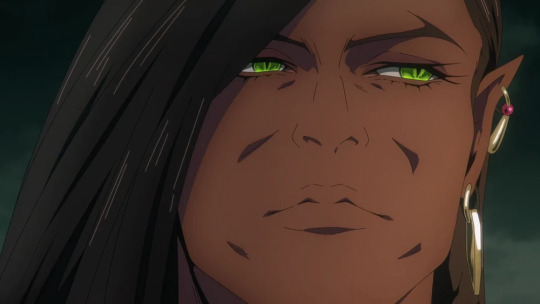
Okay, let me prephase this with one important message: Castlevania Nocturne made me really happy by making the plot all about colonialism, as colonialism and its fallout and how it influences us to this day is a topic that I am very passionate about. We do not talk enough about it. The US does not talk enough about it because it could make white people feel uncomfortable. And here in Germany we do not talk about it, because we act as if this had nothing to do with us at all.
But the show talks about it and I love it.
And I honestly also gotta say that I love that the BI_PoC character have a concrete cultural heritage. Olrox is Aztec, Annette is Yoruba, and Drolta is Egyptian. Other shows: Please take notes!
But let's talk Olrox, because he is so fucking interesting and amazing!
We know about him that he is Aztec and also that he is 250 years old. Or roughly that old by the time he kills Julia. Which would put either his birth or his turning somewhere around 1530.
Now, the fall of the Aztec Empire has a very exact date: August 13th, 1521. But you should keep in mind that this does not mean that on that day the Aztec's are extinct. To this day there is still 1,5 million people speaking Nahuatl, the language of the Aztecs, and preserving some of the Aztec cultural traditions. It was just that on that day the empire construct fell to Cortez and the Spaniad conquistadors and a lot of Aztecs went into exile to flee the genocide that Cortez was bringing upon them.
The question of course is: Was Olrox still human at this time or was he already a vampire? From his dialogue it is clear that he was at least alive and grown enough to remember the fall of the empire and the distruction Cortez and his men brought upon them. But you can bet it was very traumatic.
I also am assuming he was turned by a white man. Because so far my assumption is that vampirism is an old world thing that got brought to the new world through colonialism. (Mostly because in Dracula's court we do not see any new world vampires.)

Now, the other interesting thing is what he says about his dead lover. The one Julia killed. So, first the "town in Massachusetts" he speaks about is clearly Stockbridge. Which was the town in which many Mohicans have settled during the colonial times, as well as other people from the Iroquois Nations. Now, it should be noted that the Mohicans were not part of the Iroquois alliance and in fact went to war with the Iroquois, but by the time colonialism really geared up there was some cooperation between the Mohicans and Iroquois.
Due to this they were in an alliance with the Oneida (who were part of the Iroquois) by the time of the Revolutionary war. Now, the Revolutionary War created a lot of conflict between the Iroquois nations, because they did not agree which side they should fight on. Of course both sides promised that they could keep their land, but the Mohawk, Onondaga, Cayuga, and Seneca did not trust the colonists and hence sided with the British, while the Oneida and Tuscarora (and through them also the Mohicans) sided with the Colonists.
And the dead lover clearly was among those siding with the colonists. Now, a quick refresher for the non-Americans (and the Americans who slept to history class, which is understandable). The Revolutionary War lasted from April 19, 1775 to September 3, 1783 (which, yes, also means that Julia and Richter probably were in the US during the war the entire time and the "evil" Julia was fighting probably was linked to it). And of course we all know how it ended for the Indigenous people: The colonists won, countless Indigenous folks died on both sides, only to get booted of their land soon after. The Oneida und Mohicans were made to move westwards not soon after the war ended. So, yes, Olrox would have seen that happen.
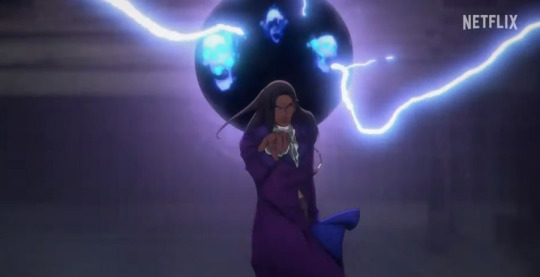
Now, an interesting thing in his dialogue was when Erzebet said: "We will create a new world." To which he replies: "I have heard that one before." And she says: "This time we are going to make it to last."
And the big question is to what this is refering. Is it refering to the colonialization or is it refering to the revolutionary war? Or something entirely different. In both cases it would be possible. And yes, the American Revolution definitely were claiming to create a new world. But was it that what he refered to or something else?
Well, never the less: Interesting character. Really good writing.
#castlevania#castlevania nocturne#castlevania netflix#castlevania nocturne spoilers#castlevania olrox#american history#history#colonialism#colonial history#aztec
4K notes
·
View notes
Text


"Am I a joke to you?"
#black sails#memes#urca de lima#1715 treasure fleet#captain flint#james flint#james mcgraw#treasure island#starz#piratecore#pirates#pirate captain#treasure#treasure fleet#spanish treasure galleon#spanish treasure#spanish florida#florida#history#floridian history#american history#us history#colonial history#funny#archaeology
539 notes
·
View notes
Text
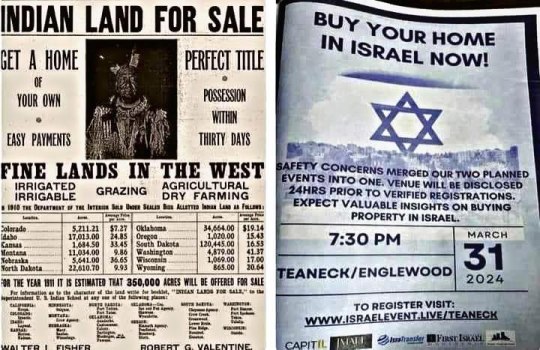
Colonialism
#Colonialism#colonialism#colonial violence#colonization#colonizers#colonial america#colonial history#colonialization#ausgov#politas#auspol#tasgov#taspol#australia#fuck neoliberals#neoliberal capitalism#anthony albanese#albanese government#usa news#usa politics#usa is a terrorist state#usa#american indian#american#america#palestine#israel#israhell#anti colonialism#anti colonization
907 notes
·
View notes
Text








There is nothing to celebrate today. If you are one of the lucky few with today off (as I am), take some time to learn why.
#LandBack
Repost from @intersectionalenvironmentalist
•
There is no pride in genocide.
As the U.S. celebrates Independence Day, we cannot dismiss the continuous acts of injustice against Black and Indigenous people.
✏️About the Researcher: @kianna_pete
Kianna was a Spring 2022 Social Media Fellow at IE and studied political science and ethnicity & race studies with a specialization in Indigenous/Native studies at Columbia University. ✨
💻Sources:
peoplesworld.org/article/july-4th-whose-independence-day-is-it/
nbcnews.com/news/us-news/six-things-you-didn-t-know-about-
fourth-july-n779331
smithsonianmag.com/blogs/national-museum-american-indian/
2020/07/01/do-american-indians-celebrate-4th-july/
meaww.com/independence-day-july-4-native-americans-do-they-celebrate-lost-traditions-early-suppression
culturalsurvival.org/news/united-states-independence-masked-genocide-and-imperialism
#fourth of july#4th of july#july 4th#human rights#indigenous#indigenous rights#colonization#colonialism#colonial violence#decolonization#turtle island#united states#us government#us politics#justice#activism#enviromentalism#climate crisis#climate justice#native american#us history#american history
402 notes
·
View notes
Text

“The American Revolution was not revolutionary.” Since the colonial rebellion maintained the same slavery, wealth inequity, and power of White elites it had under Britain, was it just another war?
x
#american revolution#colonial rebellion#slavery#wealth inequality#white elites#revolutionary war#historical analysis#american history#social justice#power dynamics#british colonialism#war for independence#historical debate#racism#systemic racism#racial discrimination#racial inequality#civil rights#racial equity#black lives matter#racial bias#historical racism#anti-racism#racial justice#july 4th#independence day#fourth of july#american holiday#patriotic celebration#fireworks
174 notes
·
View notes
Text
This is cursed, I must post it.
instagram
#marquis de lafayette#colonial williamsburg#18th century#american revolution#history memes#history#queue are made by history
81 notes
·
View notes
Text
Indigenous folks, ex-christians & anyone who's knowledgeable on social issues, I have two questions that have bothered me for a long while and I believe y'all might know how to answer them.
The question: I read a webcomic about community A living on an island along with another community B with different culture & beliefs from them. Community A believes that their culture & religion are the correct ones and that members of community B are dooming themselves to eternal damnation (in a religious sense) if they don't adopt the beliefs & practices of community A.
I saw someone talking about the comic in its comment section, saying that one of the characters who's a member of community B is selfish for not adopting the burial practices from community A's religion, because according to that someone, not burying their loved one like community A believes is correct is " potentially dooming their loved one to eternal damnation".
If you're indigenous, has rhetoric / talking points like this been used against your own religious / cultural practices? Could you give any concrete examples?
If you have religious trauma / are ex christian of any kind, have people used talking points like this to guilt trip, to frighten, or to shame you into obeying religious rules? (People belonging to other religions than christianity are welcome to give their perspectives as well!)
#ex religious#indigenous#indigenous rights#indigenous people#native american#ex hindu#indigenous culture#indigenous resistance#indigeneity#ex christian#ex catholic#exmo#exvangelical#ex baptist#exmormon#tw religion#indigenous history#indigenous pride#first nations#religious trauma#deconstruction#spiritual abuse#religious abuse#social justice#colonialism#colonization#ex jw#ex jehovah's witness#xtianity#religious bigotry
133 notes
·
View notes
Text
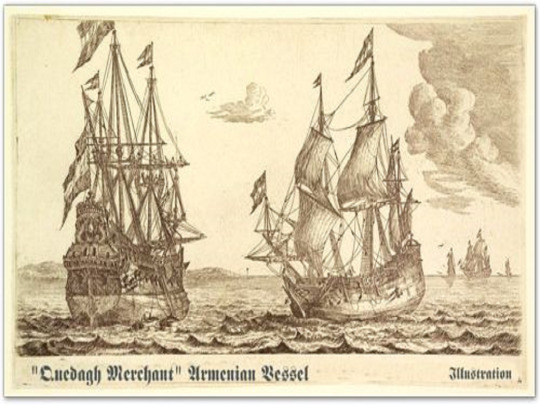
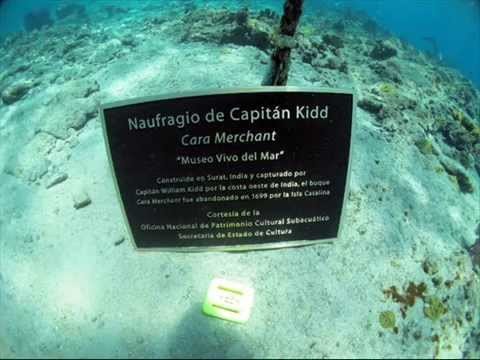
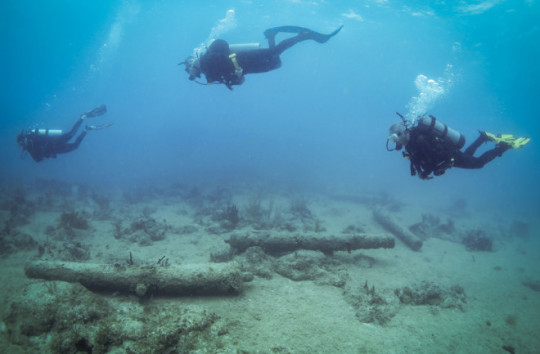
The Quedagh Merchant was Captain Kidd’s last big capture. This ship had been missing since 1699, with only a burned rope tied to a tree left behind. It had been a mystery for centuries what had happened to this vessel and if it had housed treasure on board that Kidd had claimed on his voyage. Kidd had only reported supplies, guns/cannons and a few goods on the ship, however people did not believe he told the truth since he was accused and wanted for piracy. In 2007, cannons were discovered 25 meters off the shore line of Isle de Catalina in the Dominican Republic by a snorkeler. The Dominican Republic’s Oficina Nacional de Patrimonio Cultural Subacuático (ONPCS) was contacted, who then contacted the Indiana University to have their archeology department come out and investigate the findings.
In 2008, the shipwreck was investigated and it was confirmed that this was the Quedagh Merchant’s wreck, thanks to cross referencing historical records, documents and data. One document they used was the written testimony from William Kidd himself, reporting a description of the Quedagh Merchant and its cargo:
“And that there is on board the same the Several Goods following first About one hundred and fifty bayles Seventy or eighty Tons of Sugar About ten Tons of Iron in short junks About fourteen or fifteen anchors Forty Tons of Salt Peter About Twenty Guns in the hold Thirty Guns mounted being the Guns lately belonging to the Adventure Galley There is no gold or silver on board that he knows of saith he The Ship is about four hundred tons in burthen built at Surrat by the Moors. All her seams are rabbeted.”
After surveying and identifying the contents at the shipwreck, it was confirmed that all of the non organic matter matched Kidd’s testimony. Having this evidence helps further argue Kidd’s honest intent with his return to the colonies. He did not want to hide or run, because he knew he had not committed any piracy.
You can read more about this shipwreck and its history in Captain Kidd’s Lost Ship: The Wreck of the Quedagh Merchant by Fredrick H. Hanselmann
#captain kidd#william kidd#kidd#pardon captain kidd#history#pirate history#american colony history#american history#scottish#captain#nautical history#nautical#pirate#privateer#pardon#go fund me#ship wreck#archeology#underwater archaeology#quedagh merchant#merchant ship
25 notes
·
View notes
Text
A Young Person's Guide to 18th-Century Western Fashion
unabridged version at blogspot
General info Cox, Abby. "I Wore 18th-Century Clothing *Every Day for 5 YEARS & This Is What I Learned (Corsets Aren't Bad!)." YouTube. May 10, 2020. Cullen, Oriole. “Eighteenth-Century European Dress.” In Heilbrunn Timeline of Art History. New York: The Metropolitan Museum of Art, 2004. Glasscock, Jessica. "Eighteenth-Century Silhouette and Support." In Heilbrunn Timeline of Art History. New York: The Metropolitan Museum of Art, 2004. Accessories Banner, Bernadette. "Women's Pockets Weren't Always a Complete Disgrace | A Brief History: England, 15th c - 21st c." YouTube. April 10, 2021. Colonial Williamsburg. "#TradesTuesday: Men's Accessories." YouTube. June 13, 2021. Murden, Sarah. "The Georgian era fashion for straw hats." All Things Georgian. December 6, 2018. Cosmetics & hygiene Cox, Abby. "I Followed an 18th-Century Moisturizer & Sunscreen Recipe & it kinda worked??." YouTube. February 21, 2021. Cox, Abby. "We tried making *5* different 250 year old rouge (blush) recipes || [real] regencycore makeup." YouTube. August 29, 2021. JYF Museums. "Hygiene in the 18th Century | From the Farm to the Army." YouTube. August 21, 2021. Décor Heckscher, Morrison H. “American Rococo.” In Heilbrunn Timeline of Art History. New York: The Metropolitan Museum of Art, 2003. Munger, Jeffrey. “French Porcelain in the Eighteenth Century.” In Heilbrunn Timeline of Art History. New York: The Metropolitan Museum of Art, 2003. Formal wear SnappyDragon. "This dressing gown changed fashion forever : the feminist history of going out in loungewear." YouTube. April 15, 2022. Stowell, Lauren. "The Many Types of 18th Century Gowns." American Duchess. March 15, 2013. Zebrowska, Karolina. "Cottagecore Style Is Much Older Than You Think." YouTube. June 30, 2021. Hair care Cox, Abby. "I made 250-year-old Hair Products Using Original Recipes (and animal fat...)." YouTube. November 7, 2021. Cox, Abby. "I tried a 300-year-old hair care routine for a year & this is what I learned (it's awesome!)." YouTube. January 23, 2022. Cox, Abby. "What's the Deal with 18th Century Wigs? (and why Bridgerton really messed this up)." YouTube. June 1, 2023. Laundry Cox, Abby. "Making 300 Year Old SLIME for Laundry Day." YouTube. June 15, 2023. Townsends. "Historical Laundry Part 2: No Washing Machine, No Dryer, Hit It With A Stick?" YouTube. June 3, 2019. Outer- & working-wear JYF Museum. "Getting Dressed | Clothing for an 18th Century Middling Woman." YouTube. March 18, 2021. Major, Joanne. "The practicalities of wearing riding habits, and riding ‘en cavalier’." All Things Georgian. March 12, 2019. Rudolph, Nicole. "What did Pirates ACTUALLY Wear? Fashion at Sea in the 18th c & Our Flag Means Death Costumes." YouTube. May 8, 2022. Shoes Chin, Cynthia E. "Martha Washington's Shoes." George Washington's Mount Vernon. No date. Murden, Sarah. "18th-century shoes." All Things Georgian. December 15, 2015. Rudolph, Nicole. "Real 18th century Shoes? Historical Shoemaker Examines an Antique." YouTube. December 13, 2020. Textiles Cox, Abby. "18th Century Printed Cotton Do's & Don't's." American Duchess. December 23, 2019. Stowell, Lauren. "Fabrics for the 18th Century and Beyond." American Duchess. June 14, 2021. Townsends. "Oil Cloth - Waterproof Coverings for Your Campsite." YouTube. July 30, 2018. Undergarments Major, Joanne. "Quilted Petticoats: worn by all women and useful in more ways than one." All Things Georgian. November 20, 2018. Rudolph, Nicole. "Making 18th century Stays for the Ideal Body Shape : Historical Undergarments." YouTube. August 12, 2023. SnappyDragon. "RUMP ROAST : Ranking historical fashion's wildest fake butt pads." YouTube. October 27, 2023. Townsends. "Sewing Histories' Most Popular Garment - The Fabric Of History - Townsends." YouTube. September 3, 2022.
#reference#history#abby cox#bernadette banner#fashion#hair care#hairstyle#youtube#video#nicole rudolph#townsends#us history#american history#colonial williamsburg#jamestown#georgian era#rococo#1700s#american duchess#mount vernon#bridgerton#the metropolitan museum of art#our flag means death
195 notes
·
View notes
Text
Unrolled twitter thread by Progressive International (@ProgIntl)
30 Sept 24 • 4 minute read • Read on X
On 30 September 1965, the Indonesian military, working closely with the US government, initiated a coup that would depose President Sukarno and install the brutal, 30-year dictatorship of General Suharto.
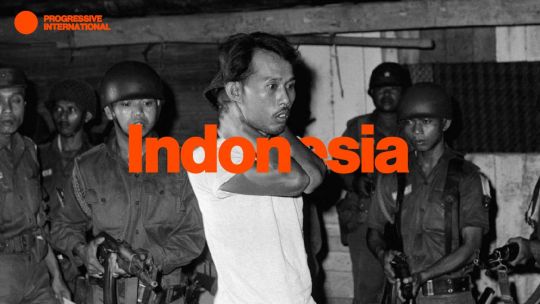
In the dark years that followed, the dictatorship massacred over a million Indonesian communists, with the CIA and US diplomats drawing up “kill lists” for the Indonesian military. The operation would become a template for the US’s regime change operations for decades to come.
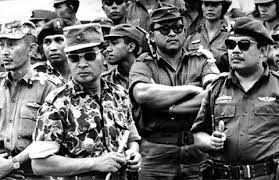
Major-General Suharto with Indonesian Army in 1966
In 1945, President Sukarno led Indonesia to independence from Dutch colonial rule. He championed the Non-Aligned Movement and hosted the historic Bandung Conference, a meeting of Afro-Asian states, in 1955.
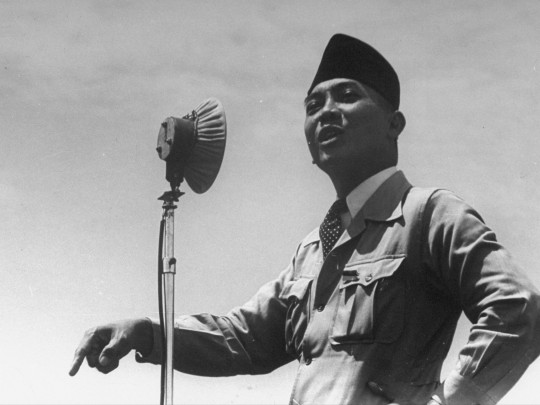
First President of Indonesia Sukarno making a speech circa 1945
Opening the conference and forecasting what was to come, Sukarno said: “We are often told ‘Colonialism is dead’. Let us not be deceived or even soothed by that… Colonialism also has its modern dress, in the form of economic control, intellectual control, actual physical control by a small, but alien community within a nation.”
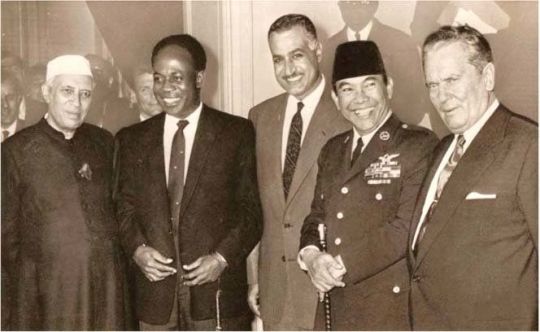
Leaders attending the Bandung Conference 1955 in Bandung, Indonesia. From left: Indian Prime Minister Jawaharlal Nehru, Ghanian Prime Minister Kwame Nkrumah, Egyptian Prime Minister Gamal Abdel Nasser, President Sukarno, and Yugoslavian Prime Minister Josip Broz Tito.
By 1965, Indonesia possessed one of the world's largest communist parties, the PKI. The PKI had a mass membership and mobilized vast numbers of people in the battle against Indonesia’s ruling class.
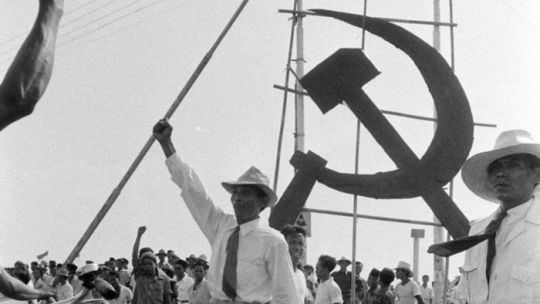
Campaign of the Indonesian Communist Party (PKI) in September 1955.
Terrified by the strength and organization of Indonesia’s people, the Indonesian military’s 30th September Movement began to purge the PKI.
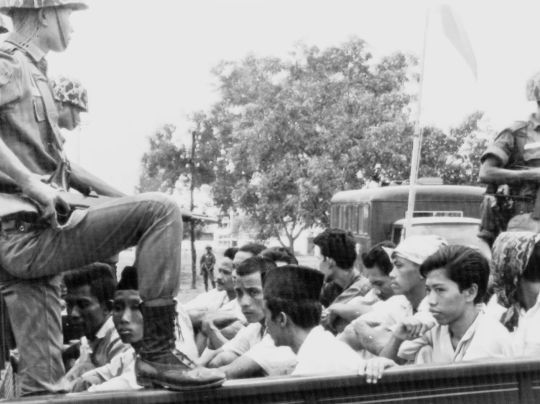
Men suspected of being IPK members being transported under guard by an armed Indonesian soldier
In the early hours of 1 October, a group of military conscripts murdered six high-ranking generals. Blaming the deaths on the PKI, Suharto used the attacks as a pretext to seize power. CIA communications equipment allowed him to spread false reports around the country and begin a long campaign of anti-communist propaganda.

The US had tried to overthrow Sukarno for years; in 1958, the CIA backed armed regional rebellions against the central government. In 1965, they did all they could to aid Suharto’s murderous power grab.
The campaign soon became genocidal. On islands like Bali, up to 10% of the population was massacred — and luxury hotels soon began to appear over the killing fields.
One US embassy staffer told the US press that Suharto’s military “probably killed a lot of people, and I probably have a lot of blood on my hands, but that's not all bad.”
Time Magazine referred to the killings as “the West’s best news for years in Asia”.

A cable from the US embassy’s first secretary, Mary Vance Trent, to the State Department referred to events in Indonesia as a “fantastic switch which has occurred over 10 short weeks”. It also included an estimate that 100,000 people had been slaughtered.
Cementing his power, Suharto became president in 1967. His ‘New Order’ policy allowed Western capitalism to exploit Indonesia’s cheap labour and plunder its natural resources. Civil rights and dissent were suppressed.
In one of the world’s most populous countries, any possibility for the emergence of a new, democratic political project was eliminated. Richard Nixon described Indonesia as “the greatest prize in Southeast Asia”. Suharto would not leave office until 1998.

U.S. President Ronald Reagan stands with Indonesian President Suharto in the White House South Lawn at the arrival ceremony for Suharto's State Visit. Oct 12, 1982
CIA officers described Suharto’s rise to power and anti-communist purge as the “model operation” and “Jakarta” soon became the codeword for anti-communist extermination programs in Latin America, where hundreds of thousands were massacred in regime change efforts engineered by Washington.
#cold war#us imperialism#american imperialism#western imperialism#indonesia#indonesian history#politicide#indonesian genocide#cia#world history#general suharto#president sukarno#anti imperialism#communist history#decolonization#colonialism#southeast asia#1965 genocide#30 September Movement#balinese genocide#bali#indonesian killing fields#progressive international#knee of huss
72 notes
·
View notes
Text


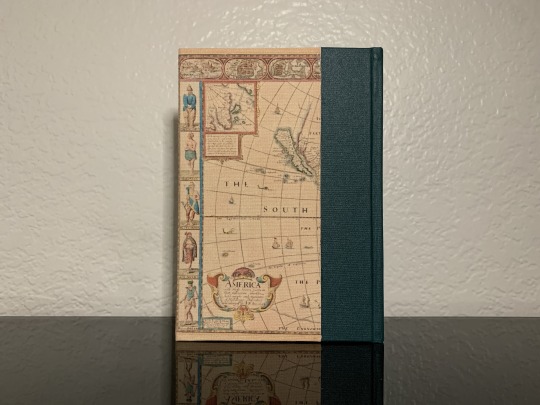

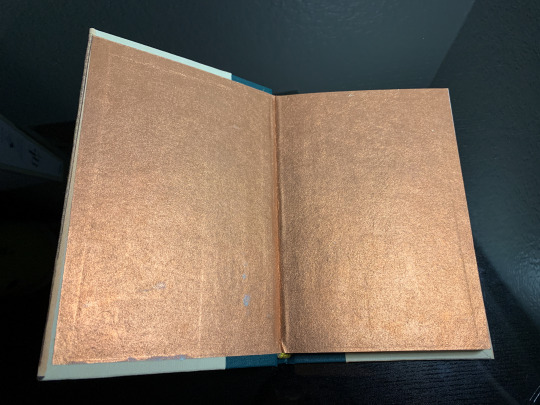
Open Veins of Latin America by Eduardo Galeano
Spine bookcloth is Forest Green Allure Bookcloth from Hollanders. I used ArtDeco rose gold heat transfer foil for the title on the spine which was applied using a foiling quill. The endpapers are lokta metallic copper paper. I once again printed on wooqu ivory bookcloth for the cover. The map image printed on the front and back covers is an early map created by John Speed (1552?-1629), viewable in the Library of Congress online catalog (control number 76690846). The endbands are handsewn with yellow and brown cosmo cotton embroidery floss.
Special thanks to Mourning Mountains Bindery (@mourningmountainsbindery) for letting me use her homemade plough for this book.
#book binding#hand bound books#handmade books#hand made#colonialism#history#latin america#imperialism#renegade bookbinding#nonfiction#colonial history#american imperialism#western imperialism#bookbinding#handmade#handbound book#arts and crafts#bookbinder#fanbinding#hand bound book#artists on tumblr#renegadepub
33 notes
·
View notes
Text
Olrox, the Conquest of the Nahua, and Why Hernan Cortez is one of the Biggest Assholes of History

One of my most liked posts here on tumblr - outside of some shitposts - is the one I did about the historical context of Olrox in season 1 of Nocturne. It just so happens that reading a lot of anthropological works during the last year, I also learned a lot about both the Nahua, the conquest of their culture, and about what a massive fucking dick Hernan Cortez was.
So, let me once again share this with you.
As I noted: In 1783 Olrox says he is 250 years old. While this might be a rounded number, this would mean he hsa been turned around the 1530s. Though given that in season 2 he speaks specifically about how the Nahua Empire fell, I would assume he was at least born around 1500, if not in the 1490s. Looking at the design I would guess he was around 30 years old when he was turned into a vampire.
While I would love to say: "As you know from history class", I am not kidding myself... History class has very probably not taught you much in terms of colonial history - it sure as hell has not taught me. So, I will rather say: "As you might remember from the well established bisexual masterwork The Road to El Dorado, it was the Spanish noble Hernan Cortes, who conquered the Aztec Empire" - though obviously I will keep refering to them by their Endonym, Nahua.
So, today let's talk about how that happened.
Let's Talk about the Nahua first

Let me say one thing first: Us white folks tend to go into one of two extremes when it comes to depicting indigenous people. Either as "wild savages" or as the "noble Indian". Which is why folks really know quite little about the Nahua, because most narratives about the Nahua tend to focus either 100% on the human sacrifice practiced in the Nahua culture, or on the genocide of the Nahua. And otherwise they might know about the Cortes conquest of the Nahua - in which most are not aware that there is a lot of Nahua living in Mexico to this day. More than two and a half million, to be exact. (I do not know how often I had to explain this to people when Black Panther 2 came out.)
The Nahua are an interesting case in terms of colonialism and imperialism - because they were themselves an expanding, imperialist empire. (And mind you, I am fairly certain Olrox being a Nahua is not accidental in this regard.)
By the time America was "discovered" by Europeans, the Nahua were expanding, and waging war against the cultures surrounding their lands. They were quite aggressive against some of the other indigenous cultures. And while they did not practice cattle slavery, they absolutely took war prisoners as slaves. Yes, those could be freed eventually, and usually the status of a slave was not to be inherited, it was still slavery. They also killed a lot of people from those other cultures.
In fact this was the reason why Cortés found support among other indigenous people, when he revealed he was planning on conquering the Nahua. Specifically the Tlaxcala and Cempoala helped Cortés and the conquistadors, because they (wrongly) assumed that the Spanish were safer for them than the Nahua.
This is not to say, that the Nahua were super evil or anything. Just that even among the indigenous cultures, there also were expansionist, imperialist cultures. And that history is more complicated than "good indigenous people" and "evil colonizers". And reducing the entire thing on "indigenous people are pure and good" is also a form of racism, removing the complexity from the indigenous people.
However, this fact does not remove that Hernan Cortés definitely is up there with the top historical assholes to ever do assholery.
Hernan Cortés was horrible, actually

One of the books I read on this tried to go a bit more into the worldview of the conquistadors. Basically going into why those people did those horrible things. And how basically they were so indoctrinated into the Catholic belief, that they thought that indeed if they forced their religion onto someone else on the tip of a sword, they were doing those people a favor. Because in their logic there was no question that people who did not worship the Christian God and Jesus would go to hell. And yes, that is messed up, but yeah, they got indoctrinated from birth, basically.
However, Hernan Cortés himself? He was a fucking asshole bastard, who very much was in for the money. A bit related to Castlevania Nocturne: He was related to the Spanish Governer to what later became Santa Dominque, which at this time was still Spanish controlled. And he wanted the supposed money of the New World. The gold and silver and gemstones.
So, he got some people - who for the most part really were religiously motivated - and was like: "Yeah, we gotta bring Christianity to those folks, and get some money from there. And everyone who comes with me will gets not only to go to heaven, but also a share of whatever profits we make." And then, when he arrived in America (mind you, against what he had been instructed to do - so he commited mutiny to be exact), he ordered his men to set their ships aflame, because he wanted to make sure that nobody is going to flee.
Then he made the deal with those other indigenous folks, before fighting the Nahua together with them and his own forces, who were miserable not being used to this climate. And then when he was done, he enslaved the Tlaxcala and Cempoala, while going to his own men like: "So, we got less money than expected. Everyone only will get 80 Pesos for this. Oh, by the way, you all owe me 300 Pesos for the equipment I provided to you, the food and everything. If you needed medical attention you owe me even more than that."
For reference, if I have not fully miscalculated today (it was hard to calculate, because I did not find a formular for direct calculation, so I had to go from Pesos into Real, from Real into Shilling, from Shilling into modern GBP, and from that to USD), 80 Pesos at the time are worth about 20 000 USD today, So not a whole lot for risking your life half on the other side of the world. And of course the money they supposedly owed him is then about 70 000 USD. Meanwhile he settled down in a nice pretty castle.
So yeah, Hernan Cortés, fucked everyone over. Literally EVERYONE.
Now, mind you. Because some of his people - who for the lack of money, now were stuck in the Americas - started to rise up against him, he basically calmed them by saying: "Yeah, you know what? Let enslave more indigenous people." And the fact that they were like: "I guess that is fine then" says a lot about their morals. But generally speaking... Yeah, fuck Cortés. I sure hope that asshole is somewhere deep, deep, deeeeeeeeep in hell.
And mind you, after Cortes took over what today is Mexico, it apparently got really bad. With a mixture of a famine, the slavery and the sicknesses the Spaniads brought to the place, apparently it was at times after this so bad, that there were literal dead bodies lining the streets. Some died of hunger, some of sickness, and some had been killed by the Spaniads.
#castlevania#castlevania netflix#castlevania nocturne#colonial history#colonialism#hernan cortes#aztec#aztec empire#american history#mexican history#nahua#genocide#olrox#castlevania olrox
34 notes
·
View notes